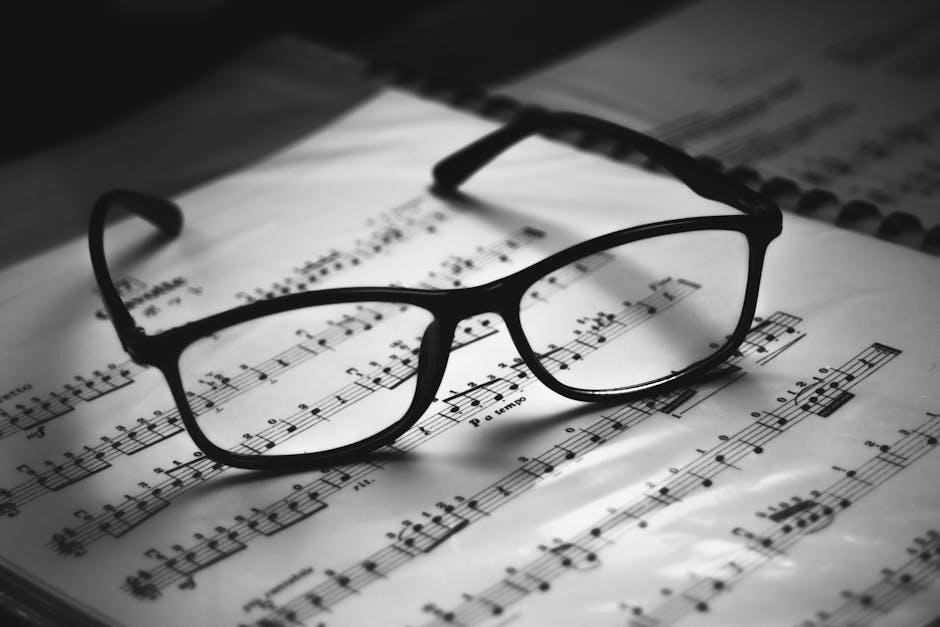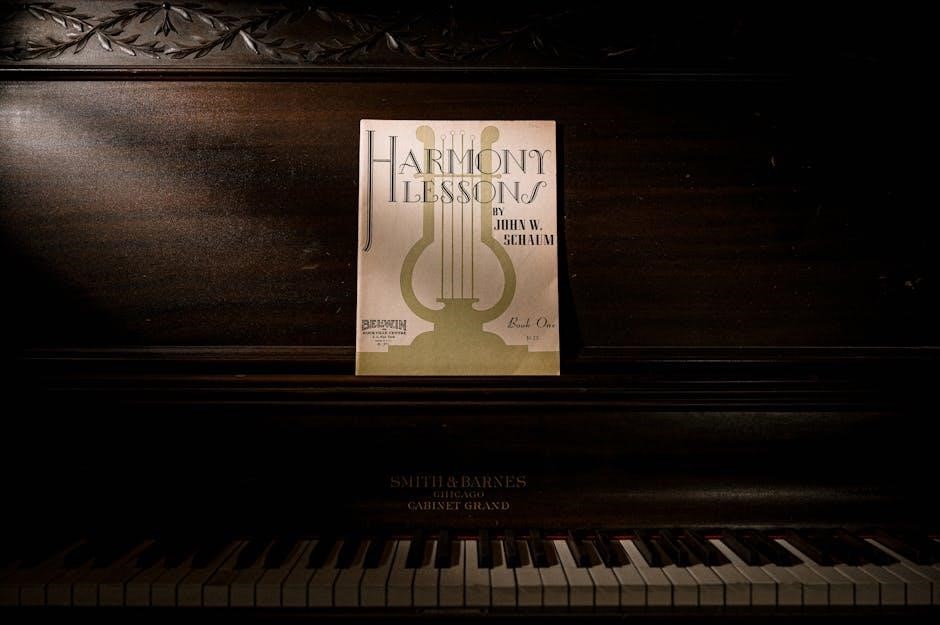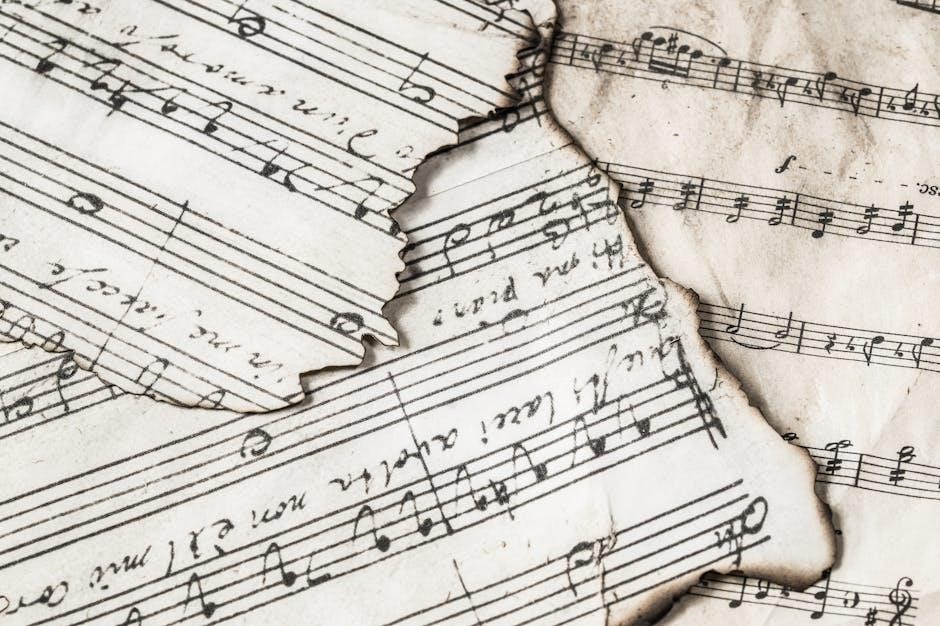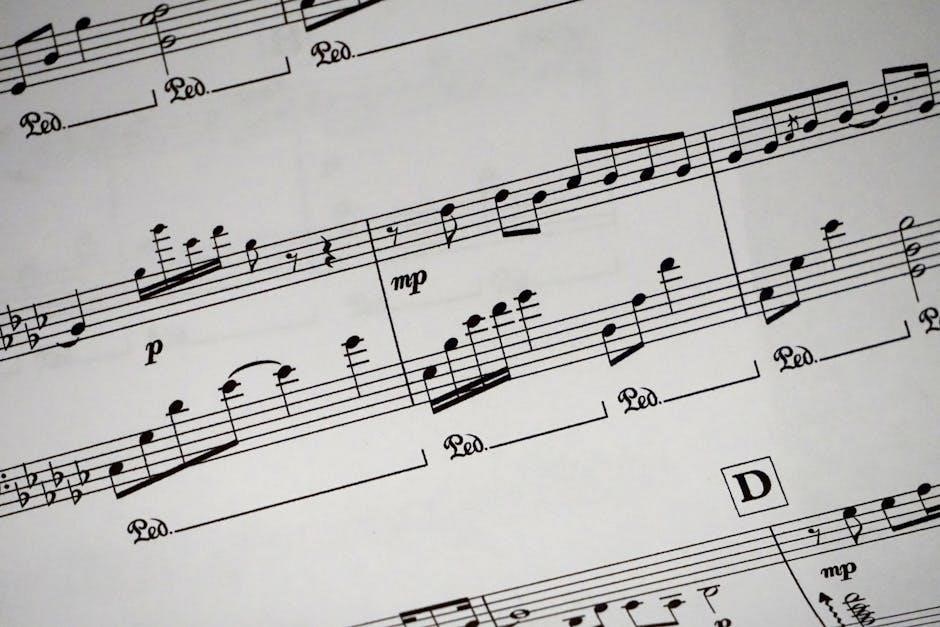Erik Satie’s Gymnopédie No. 1 is a captivating piano piece known for its soothing melody and harmonious structure. The sheet music is widely available as a free PDF download‚ allowing pianists of all levels to explore and perform this iconic work.
Overview of the Piece
Gymnopédie No. 1‚ composed by Erik Satie in 1888‚ is a groundbreaking work known for its minimalist and calming nature. The piece features a slow‚ haunting melody accompanied by subtle harmonies‚ creating a meditative atmosphere. Its structure is characterized by repetitive arpeggios in the left hand‚ while the right hand carries the melodic line‚ requiring precise finger placement and dynamics. The sheet music highlights Satie’s unconventional approach to composition‚ blending simplicity with emotional depth. This piece is considered moderately easy to play‚ making it accessible to pianists of various skill levels. Its soothing qualities and timeless appeal have made it a favorite among both classical music enthusiasts and modern audiences‚ often featured in films‚ commercials‚ and relaxing playlists.
Importance of Sheet Music in Learning the Composition
Sheet music is indispensable for mastering Gymnopédie No. 1‚ as it provides a precise guide to the composition’s structure‚ melody‚ and harmony. By following the notation‚ pianists can accurately interpret Satie’s unique style‚ ensuring the piece’s minimalist essence is preserved. The sheet music details dynamics‚ tempo‚ and phrasing‚ which are critical for conveying the work’s calm and introspective nature. It also highlights the specific finger techniques required‚ such as the left-hand arpeggios and the right-hand melodic lines. For beginners‚ the sheet music serves as a foundational tool for understanding the composition’s nuances‚ while advanced players can use it to refine their interpretation. Accessing a high-quality PDF ensures clarity and accuracy‚ making the learning process both efficient and enjoyable.
Why “Gymnopedie No. 1” is Popular Among Musicians
Gymnopédie No. 1 remains a beloved piece among musicians due to its timeless beauty and emotional depth. Its soothing‚ minimalist melody creates a sense of calm‚ making it accessible to pianists of all levels. The composition’s simplicity allows for personal interpretation‚ enabling musicians to connect with the music on a deeper level. Additionally‚ its versatility in arrangements and collaborations across genres has kept it relevant in modern music. The availability of free sheet music PDFs further enhances its popularity‚ making it easily accessible for practice and performance. Overall‚ its enduring appeal lies in its ability to evoke emotions and inspire creativity‚ solidifying its place as a favorite among musicians worldwide.

History and Background of “Gymnopedie No. 1”
Composed in 1888 by Erik Satie‚ Gymnopédie No. 1 introduced a revolutionary‚ avant-garde style. Satie‚ a French composer‚ created the term “gymnopédie‚” blending ancient Greek influences with modern minimalism.

Composer Erik Satie and His Musical Style
Erik Satie‚ a French composer and pianist‚ was known for his unconventional and innovative approach to music. Born in 1866‚ Satie broke away from the Romantic era’s grandeur‚ embracing simplicity and clarity. His compositions‚ including Gymnopédie No. 1‚ reflect a minimalist style‚ characterized by slow tempos‚ repetitive patterns‚ and harmonic ambiguity.
Satie’s music often featured humor and irony‚ challenging traditional norms. Despite initial misunderstandings‚ his work gained recognition for its originality. Gymnopédie No. 1‚ with its serene melody and subtle harmonies‚ exemplifies Satie’s ability to create timeless‚ evocative pieces that continue to inspire musicians and composers today.
Origins and Inspiration Behind the Composition
Erik Satie composed Gymnopédie No. 1 in 1888‚ during a period of personal and artistic transformation. The term “gymnopédie” was coined by Satie‚ combining the Greek words for “naked” and “song‚” possibly inspired by ancient Spartan dances. The piece reflects Satie’s fascination with simplicity‚ calmness‚ and unconventional harmonies.
The composition was influenced by Satie’s association with the Rosicrucian movement‚ which emphasized mysticism and ancient wisdom. He sought to create music that was introspective and free from Romantic-era dramatics. The serene‚ slow melody and minimalistic structure of Gymnopédie No. 1 showcase Satie’s innovative approach to music‚ blending elements of modernism with a nod to antiquity.
Though initially overlooked‚ the piece gained popularity after Claude Debussy orchestrated it‚ revealing its timeless appeal. Its calming‚ meditative quality continues to resonate with audiences and musicians alike.
Publication and Initial Reception
Gymnopédie No. 1 was first published in 1888 by Erik Satie‚ though it initially received little recognition. The piece was considered radical for its time‚ as it defied traditional musical structures and harmonic conventions. Satie self-published the work‚ which limited its early dissemination and contributed to its relative obscurity.
The initial reception was lukewarm‚ with many critics and musicians failing to grasp the piece’s innovative qualities. Its minimalist and introspective nature was seen as unconventional‚ contrasting sharply with the dramatic and complex compositions of the Romantic era. Despite this‚ Satie remained committed to his artistic vision‚ believing in the value of simplicity and calmness in music.
It wasn’t until Claude Debussy orchestrated Gymnopédie No. 1 in 1897 that the piece began to gain widespread recognition. This adaptation introduced Satie’s work to a broader audience‚ helping to establish its reputation as a landmark of modern music. Over time‚ the piece has become celebrated for its timeless beauty and emotional depth.

Structure and Composition of “Gymnopedie No. 1”

Gymnopédie No. 1 is written in 3/4 time‚ featuring a hypnotic‚ repeating melody over a simple left-hand accompaniment. This creates a soothing‚ meditative atmosphere‚ defining its structure and composition.
Musical Form and Structure
The musical form of Gymnopédie No. 1 is characterized by its simplicity and repetitive structure‚ which contributes to its meditative and hypnotic quality. The piece is written in 3/4 time‚ creating a waltz-like rhythm‚ though it is performed at a slower tempo. It follows a ternary form (A-B-A)‚ with three main thematic sections. The first section introduces the primary melody‚ played by the right hand over a steady left-hand accompaniment. The middle section presents a contrasting theme‚ adding variety while maintaining the piece’s calm atmosphere. The final section returns to the original theme‚ providing a sense of closure. Satie’s use of modulation and subtle harmonic shifts adds depth to the composition without disrupting its serene nature. This structure makes the piece accessible yet emotionally engaging for both performers and listeners.
Key Features of the Melody and Harmony
The melody of Gymnopédie No. 1 is renowned for its simplicity and flowing nature‚ often described as gentle and lulling. It typically features a smooth‚ stepwise motion with occasional leaps‚ creating a calming effect. The harmony‚ while unconventional‚ supports the melody with a steady foundation‚ often incorporating modal interchange and extended chords that give the piece its distinctive tonal color. Satie’s use of ostinatos in the left-hand accompaniment adds a hypnotic quality‚ enhancing the meditative atmosphere. The piece maintains soft dynamics and legato articulation‚ contributing to its serene mood. Structurally‚ it follows a ternary form‚ with the melody and harmony reinforcing the peaceful and unchanging feel‚ making it both accessible and memorable. These elements collectively create a composition that is both innovative and deeply engaging‚ reflecting Satie’s unique approach to music.
Techniques Required to Play the Piece
Performing Gymnopédie No. 1 demands a combination of technical and expressive skills. A steady tempo and precise timing are essential to maintain the piece’s calm‚ meditative character. Pianists must master legato playing to achieve the smooth‚ flowing melody‚ while also controlling dynamics to keep the overall sound soft and delicate. Articulation is key‚ with slight separations between notes to prevent muddiness. The left-hand ostinato requires consistent rhythm and finger independence‚ as it underpins the entire piece. Additionally‚ subtle use of rubato can enhance phrasing without disrupting the tranquil atmosphere. Pedaling techniques‚ such as the sustain pedal‚ help sustain the sound‚ but must be used sparingly to avoid blurring the texture. Balancing these elements ensures a nuanced and engaging performance‚ making the piece both challenging and rewarding to play.

Downloading “Gymnopedie No. 1” Sheet Music for Free
Gymnopédie No. 1 sheet music is widely available online for free. Reputable sources like MuseScore‚ IMSLP‚ and SheetMusicArchive offer high-quality PDFs. Ensure legality by verifying copyright status and opting for public domain or Creative Commons versions. Always check the PDF for completeness and clarity before downloading. This ensures a smooth and enjoyable learning experience for pianists of all levels.
Reputable Sources for Free Sheet Music
Several trusted platforms offer free “Gymnopédie No. 1” sheet music in PDF format. IMSLP (International Music Score Library Project) is a reliable source‚ providing high-quality‚ legally available scores. MuseScore also hosts user-contributed arrangements‚ often free for download. Additionally‚ websites like SheetMusicArchive specialize in classical compositions‚ offering accurate transcriptions. When searching‚ ensure the source is reputable to avoid low-quality or misattributed files. Always preview the PDF before downloading to confirm its accuracy and completeness. These platforms are excellent starting points for pianists seeking to explore Satie’s iconic piece without cost.
How to Ensure the Quality of the PDF
To ensure the quality of the “Gymnopédie No. 1” sheet music PDF‚ verify the resolution and clarity of the document. A high-quality PDF typically has a resolution of at least 300 DPI to maintain crisp notation. Check if the file includes all pages of the composition and that the layout is clean and professionally formatted. Avoid PDFs with uneven margins‚ blurred text‚ or missing measures‚ as these can hinder performance. Preview the PDF before downloading to confirm its accuracy and completeness. Reputable sources often provide metadata‚ such as the composer’s name and instrument specifications‚ ensuring authenticity. Additionally‚ use a PDF reader with zoom and annotation features to enhance your practice experience. Prioritizing quality ensures a seamless and enjoyable learning process.
Legal Considerations for Downloading Sheet Music
Downloading “Gymnopédie No. 1” sheet music as a PDF requires adherence to copyright laws. Since Erik Satie composed the piece in 1888‚ it is now in the public domain in most countries‚ meaning it can be freely downloaded and performed. However‚ specific arrangements or transcriptions may still be under copyright‚ so verify the source. Always use reputable websites that offer public domain or Creative Commons-licensed music to ensure legality. Avoid pirated or unlicensed content‚ as it violates copyright laws and supports unethical practices. Respecting intellectual property rights is essential‚ even for older works. If in doubt‚ opt for official or trusted platforms that provide clear licensing information. This ensures you enjoy the music responsibly and legally.

Playing and Interpreting “Gymnopedie No. 1”
Maintaining a steady tempo and subtle phrasing is key. Pianists should emphasize the piece’s calm‚ meditative nature while exploring dynamics and pedaling techniques to enhance its ethereal quality.
Left-Hand Techniques and Finger Placement
The left-hand accompaniment in “Gymnopedie No. 1” requires a steady‚ rhythmic pattern‚ often involving arpeggiated chords or broken chords. Pianists should focus on maintaining a smooth‚ legato touch‚ with fingers placed close to the keys. The left hand primarily plays the harmonic foundation‚ so accurate finger placement is crucial for clarity. Using fingers 1‚ 2‚ and 3 for the lower notes and 4 or 5 for higher passages ensures balance. The thumb can help with octave transitions‚ while the fifth finger handles the highest notes. A relaxed hand position and wrist movement are essential to avoid fatigue. Dynamics should remain subdued‚ with the left hand providing a soft‚ pulsing rhythm that underscores the melody without overpowering it. Proper pedaling can enhance the overall sound‚ blending the left-hand textures seamlessly with the right-hand melody.
Right-Hand Dynamics and Phrasing
The right-hand melody in “Gymnopedie No. 1” is characterized by simplicity and expressive phrasing. Pianists should focus on delivering a smooth‚ cantabile line with subtle dynamic variations. The melody often begins pianissimo‚ gradually increasing to mezzo-piano before returning to a soft finish. Dynamics should be handled with care to maintain the piece’s introspective nature. Finger placement is crucial for clarity‚ with fingers 1‚ 2‚ and 3 primarily used for the melodic line. Articulation should lean toward legato‚ with slight separations between notes for a delicate feel. Phrasing can be enhanced by subtle rubato‚ allowing for expressive timing without losing the overall tempo. Attention to these details ensures the right-hand melody shines with elegance and emotional depth‚ capturing the essence of Satie’s composition.
Common Challenges and Solutions
Pianists often face challenges when interpreting “Gymnopedie No. 1‚” particularly in maintaining the piece’s hypnotic and contemplative nature. One common issue is tempo inconsistency‚ which can disrupt the flow. To address this‚ practicing with a metronome can help establish a steady pace. Another challenge is dynamic control‚ as the subtle shifts between pianissimo and mezzo-piano require precise finger placement and pedal use. Additionally‚ balancing the melody and accompaniment can be tricky‚ with the melody often overpowering the harmonies. To overcome this‚ pianists can practice the melody and accompaniment separately before combining them. Finally‚ achieving the desired rubato without losing the overall structure is challenging; careful phrasing and attention to Satie’s markings are essential. These solutions help pianists master the piece’s unique character and emotional depth;

The Appeal of “Gymnopedie No. 1” in Modern Times
Its calming‚ minimalist beauty resonates universally‚ making it a favorite in films‚ commercials‚ and modern arrangements‚ while its simplicity inspires contemporary composers and relaxes global audiences.
Its Use in Popular Media and Culture
Erik Satie’s “Gymnopedie No. 1” has become a staple in popular media‚ featured in films‚ TV shows‚ and commercials for its calming‚ nostalgic vibe. Its minimalistic melody creates a serene atmosphere‚ making it perfect for emotional or reflective scenes. The piece has been adapted into various genres‚ from electronic remixes to orchestral arrangements‚ broadening its appeal. Its presence in video games‚ relaxation playlists‚ and even social media underscores its universal charm. Additionally‚ it’s often used in wellness and yoga sessions‚ highlighting its soothing effects. The ease of adapting the composition has allowed it to transcend classical music boundaries‚ making it a favorite for modern creators seeking to evoke simplicity and elegance; Its gentle‚ timeless beauty continues to resonate‚ reinforcing its relevance in today’s fast-paced world.


Influence on Contemporary Composers
Erik Satie’s “Gymnopedie No. 1” has profoundly influenced contemporary composers‚ particularly in its minimalist and ambient approaches. The piece’s simplicity and repetitive‚ meditative structure have inspired many modern artists to explore similar techniques. Composers like Brian Eno and Ludovico Einaudi have drawn inspiration from Satie’s work‚ incorporating its calm and introspective qualities into their own music. The piece’s emotional depth and timeless appeal have also encouraged experimentation across genres‚ from electronic to neoclassical. Its influence is evident in film scores‚ ambient music‚ and even pop culture‚ where its themes are often reimagined. By breaking traditional norms‚ Satie’s “Gymnopedie No. 1” has become a cornerstone for modern composers seeking to create evocative and emotionally resonant music. Its accessibility through free sheet music has further amplified its reach‚ inspiring a new generation of musicians to embrace minimalism and innovation in their craft.
Why It Remains a Favorite Among Pianists
“Gymnopedie No. 1” remains a beloved piece among pianists due to its timeless beauty and emotional depth. Its simple yet profound melody allows for personal interpretation‚ making it a favorite for both beginner and advanced players. The piece’s calm and meditative nature provides a therapeutic experience during practice‚ while its elegance shines in performance. Pianists appreciate its accessibility‚ as it requires a moderate level of technical skill‚ making it rewarding to master. Additionally‚ the composition’s versatility enables it to be played in various settings‚ from intimate gatherings to professional concerts. Its enduring popularity stems from its ability to evoke a deep emotional connection‚ which resonates with both performers and audiences. This timeless appeal ensures that “Gymnopedie No. 1” continues to be a staple in pianists’ repertoires‚ offering a unique blend of simplicity and sophistication.

